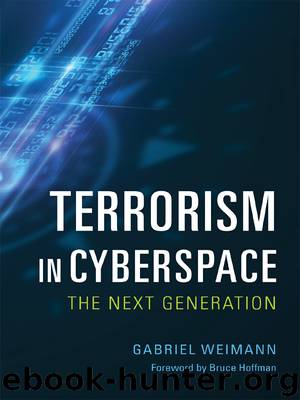Terrorism in Cyberspace by Gabriel Weimann

Author:Gabriel Weimann
Language: eng
Format: epub
Tags: POL037000, Political Science/Political Freedom & Security/Terrorism, SCI075000, Science/Philosophy and Social Aspects
Publisher: Columbia University Press
Published: 2015-02-02T16:00:00+00:00
Vatis’s list provides a basis for classifying potential cyberattackers, though it does not include other categories of cyberattackers, including criminals who engage in extortion, identity theft, credit card and bank fraud, and corporate espionage; and “insiders” who engage in sabotage, fraud, and so on in systems to which they already have access.
The Appeal of Cyberterrorism
Cyberterrorism is an attractive option for modern terrorists for several reasons:
• Minimal resources required: Cyberterrorism is cheaper than traditional terrorist methods. All that the terrorist needs is a personal computer and an online connection. Terrorists do not need to buy weapons such as guns and explosives; instead, they can launch digital attacks through a telephone line, a cable, or a wireless connection. The minimal resources that are needed for such an attack—one person in front of a computer connected to the Internet—helps groups that have limited funds.
• Anonymity: Cyberterrorism is more anonymous than traditional terrorist methods. Like many Internet surfers, terrorists use online nicknames—“screen names”—or log on to a website as an unidentified “guest user,” which makes it harder for security agencies and police forces to track down their real identity. Cyberspace also has no physical barriers to overcome, such as checkpoints to navigate, borders to cross, or customs agents to outsmart.
• Remote attacks: Cyberterrorism can be conducted remotely, a feature that is especially appealing to terrorists. In fact, a terrorist at a computer on one side of the world can launch an attack, route it through dozens of different countries, cover his tracks so that it is nearly untraceable, and cause great damage to a society or nation on the other side of the globe.
• Vulnerabilities: The variety and number of targets are enormous. Cyberterrorists can target the computers and computer networks of governments, individuals, public utilities, private airlines, and so forth. The sheer number and complexity of potential targets guarantee that terrorists can find weaknesses and vulnerabilities to exploit. Several studies have shown that critical infrastructures such as electric power grids and emergency services are vulnerable to a cyberterrorist attack because both the infrastructures and the computer systems that run them are highly complex, making it effectively impossible to eliminate all weaknesses.
• Scope of damage: The potential scope of damage is another attractive feature of cyberterrorism. Consider the following comparative scenario: A suicide bomber can enter a bus, and if successful can manage to kill all the passengers on the bus and possibly harm bystanders and others in the immediate area. With cyberattacks, a terrorist can take control of traffic lights in a certain area, the air traffic control systems of a busy airport, or the computers controlling the underground transport system in a major city—and could cause hundreds or even thousands of fatalities over a much wider area.1
• Greater “fear factor”: Cyberterrorism fits with terrorists’ goals of infusing fear into the lives of their enemies. Cyberterrorism can come without any warning, and there is not much that ordinary civilians can do to protect themselves against such attacks. This uncertainty and lack of control over one’s own world make the prospect of this form of terrorism such a dreadful option.
Download
This site does not store any files on its server. We only index and link to content provided by other sites. Please contact the content providers to delete copyright contents if any and email us, we'll remove relevant links or contents immediately.
| Elections & Political Process | Ideologies & Doctrines |
| International & World Politics | Political Science |
| Public Affairs & Policy | Specific Topics |
| United States |
The Secret History by Donna Tartt(18844)
The Social Justice Warrior Handbook by Lisa De Pasquale(12141)
Thirteen Reasons Why by Jay Asher(8793)
This Is How You Lose Her by Junot Diaz(6794)
Weapons of Math Destruction by Cathy O'Neil(6142)
Zero to One by Peter Thiel(5685)
Beartown by Fredrik Backman(5596)
The Myth of the Strong Leader by Archie Brown(5425)
The Fire Next Time by James Baldwin(5248)
How Democracies Die by Steven Levitsky & Daniel Ziblatt(5127)
Promise Me, Dad by Joe Biden(5087)
Stone's Rules by Roger Stone(5026)
A Higher Loyalty: Truth, Lies, and Leadership by James Comey(4843)
100 Deadly Skills by Clint Emerson(4840)
Rise and Kill First by Ronen Bergman(4702)
Secrecy World by Jake Bernstein(4644)
The David Icke Guide to the Global Conspiracy (and how to end it) by David Icke(4625)
The Farm by Tom Rob Smith(4435)
The Doomsday Machine by Daniel Ellsberg(4416)
